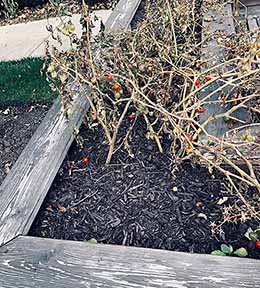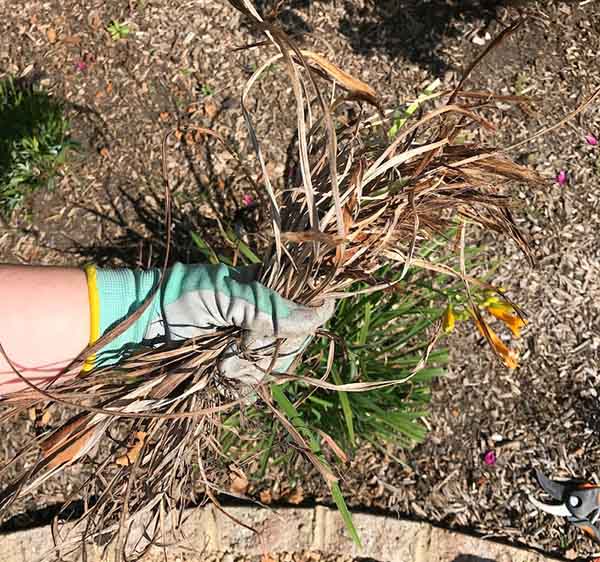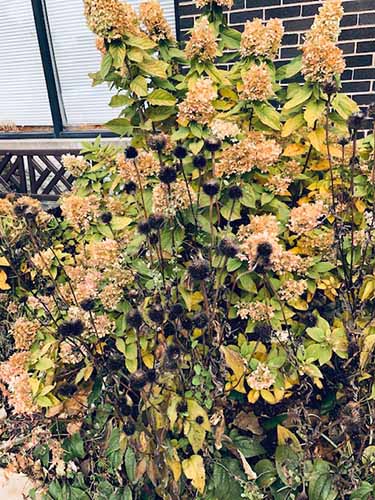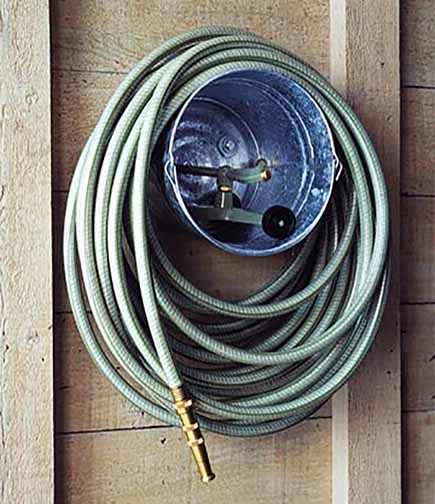We love the beautiful array of colors Fall brings to our landscape! But we may not like the mess Fall can leave behind. Get ahead of Fall this year by following our essential Fall Clean-Up Checklist to ensure a smooth transition in your garden this season.
Leaves: Don’t Blow Them, Mow Them
Did you know that mowing leaves into your grass is beneficial? Doing so provides nutrients to the soil and serves as an organic compost. The key is to mow the leaves as long as you can still see the grass. There is such a thing as too much mulch, be careful not to suffocate your lawn. Have a leaf surplus? Add the bag attachment to your lawn mower and collect the leaves for compost bins. Combine mulched leaves with grass, sticks and soil to compile compost that is full of nitrogen, which is great for vegetable gardens or shrub plantings.
Weeds & Seeds
Now is a great time to get ahead of those weeds and remove them, especially those pesky dandelions. Pulling weeds is still the safest and most effective way to rid of the unwelcome nuisance. You may also want to consider spraying an organic herbicide if the problem is too much to handle. Now is a good time to identify and pull Crabgrass as well.

Clean Up Vegetable Beds
Clear out all spent vegetables, fruit and debris to prevent pests and diseases. Check for diseased plants and remove them. Do not compost diseased plants, doing so will harm future yield. Once you have cleaned out the beds, collect fallen leaves and add to the beds. Use whole leaves rather than mulched leaves to avoid destroying caterpillars and chrysalis that often lay in leaves. Whole leaves also provide more nutrients to the soil by acting as a shelter for organisms to thrive. Find out more about our Organic Lawn Care Program and boost your garden’s productivity next season!

Cut Down Spent Perennials
Perennials you should cut back include:
- Peony
- Daylilies
- Iris
- Ferns
- Hostas
Remove anything that has wilted, browned or laying flat on the ground. Inspect plants and remove all diseased leaves or stems and discard.

Perennials to Leave on Site
Once you have cleared garden beds of debris and diseased plants, perennials you should keep and are those with color this time of year. These plants are considered semi-evergreen and should not be cut down or pruned due to the plant’s need for the leaves late in the season.
- Huechera (Coral Bells)
- Lavender
- Lady’s Mantle and Geranium
- Liriope and Sedges
- Vines and other groundcovers with green leaves

Plants that are stiff and upright with firm seed heads and or with dried flowers can be left for winter interest and wildlife habitat.
- Ornamental Grasses
- Astilbe
- Coneflower
- Black-eyed Susan
- Hydrangea Shrubs
- Clematis Vine
- Yarrow
- Spirea Shrubs

Remove Annual Foliage
Remove spent annuals from flowers boxes, garden beds and flower pots. Don’t forget to store all unused ceramic pots indoors to avoid breakage. Utilize the soil from the unused pots to amend garden soils.

Store Potted Plants
Bring potted plants indoors once temperatures hit overnight frost lows. The warm inviting soil of tropical plants are havens for critters such as ants and spider mites in the Summer. Flush out the pots with water multiple times to avoid bringing unwelcome pests indoors. Here’s another tip: save your bubble wrap from shipping packages and wrap your pots for cold winter storage.

Winterize Plants
Protect Evergreens from salt spray damage by wrapping them in burlap. Cover the crown of newly installed shrubs or tender Roses with mulch. You can also use a collection of fall leaves as an added layer of protection either under mulch or solo. The leaf barrier serves as food for the soil as it deteriorates into Spring.
Check out our blog on Winter Evergreens
Mulch
Fall and Spring are great times to mulch garden beds. Mulch provides a layer of protection for large temperature swings, retains soil moisture balance and helps prevent weeds. Mulch also breaks down and feeds the soil organically.
The small investment in purchasing good quality mulch means healthier plants during the growing season.
Drain and Store Garden Hoses
Now that watering season has ended, unhook garden hoses and drain them to avoid cracking during the freezing months. It is best to store garden hoses in a shed, or garage and keep away from the harsh elements. You may also want to invest in some outdoor faucet covers for additional protection. Also, don’t forget to clean off and store your outdoor furniture and cushions. Follow us on FaceBook for additional tips and recommendations!

